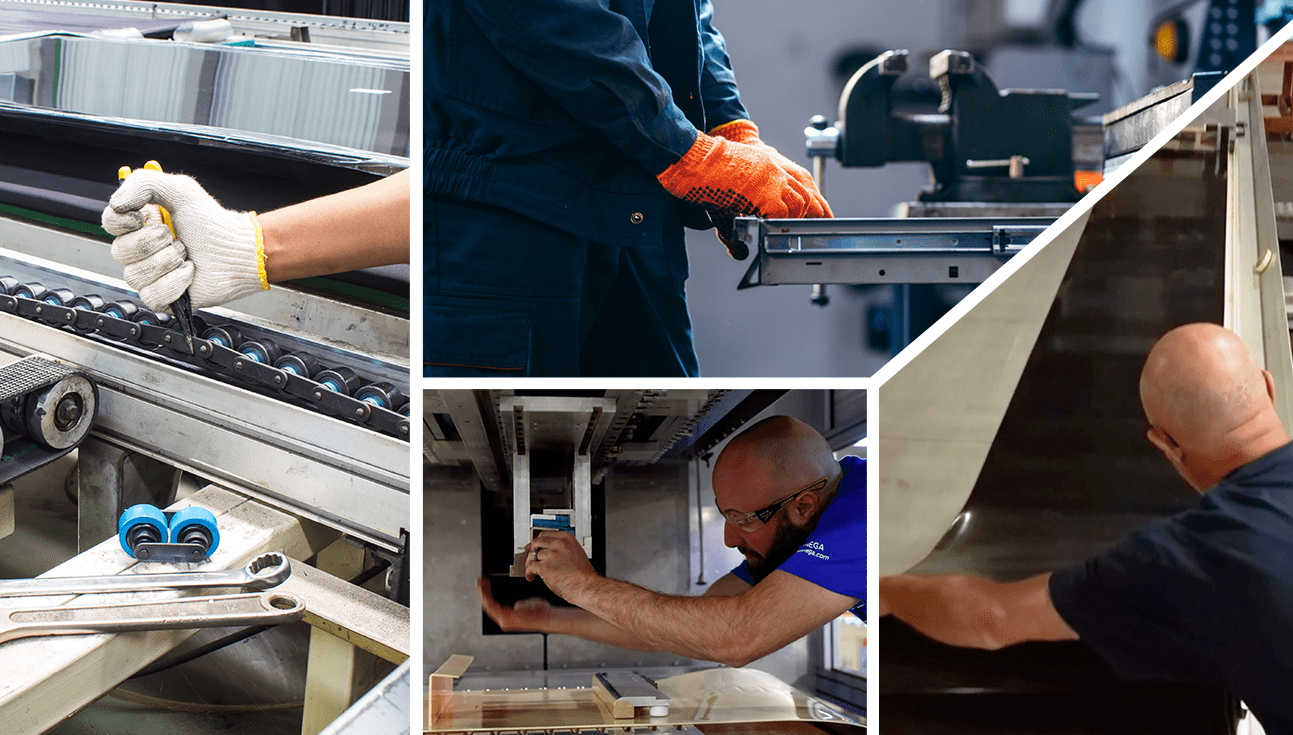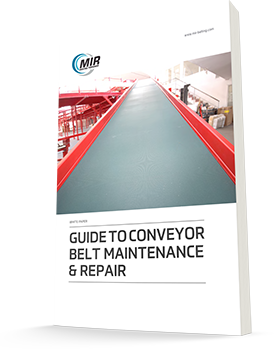Tracking is essential to an efficient and reliable conveyor system. It’s also an extremely complex part of conveyor belt maintenance, as a multitude of ever-changing factors can affect the quality of belt tracking.
Conveyor belt technicians are your most knowledgeable resource on solving a tracking problem. But there are simple components of your conveyor system you can troubleshoot beforehand. After briefly going over the importance of conveyor belt tracking, we’ll describe the basic elements of a tracking system and potential causes of mis-tracking. With this information, you’ll play an active part in keeping your belts running straight.

Why conveyor belt tracking is important
Simply put, all of the key factors of a highly efficient and productive plant are in jeopardy if you can’t track your belts. If you don’t address mis-tracking, the risks for your plant include:
- Limited belt life and higher belt turnover
- Signs of wear on belts causing food safety inspectors to call for belt replacements
- Increased waste
- Product recalls
- Reduction in throughput
By addressing mis-tracking, you can prevent these issues from hurting your plant’s reliability.
What makes up a tracking system?
Conveyor belt tracking is influenced both by the parts making up the conveyor system and the mechanical forces at work, such as friction, contact force and arc of contact with the pulley. The mechanical parts that influence tracking include:
Fabric design of the belt
The fabric design of the belt will either be multifilament or monofilament. Multifilament belts have a four-bend axis (can bend left, right, forward and backward) and are only seen on turns, troughing belts or in package handling plants. Most belts are monofilament and they only bend at two axis points (forward and backward).
Installation tension
Tension is an essential part of tracking. They key is to apply the least amount of tension for the conveyor belt to run. Installation tension depends on the fabric design of the belt: For example, monofilament belts are installed at half of one percent tension.
However, when belts are installed the general practice isn’t to measure out the tension to a percentage — most maintenance managers will simply tighten the belt until it starts to run. This isn’t incorrect and often works; however, if there is a tracking issue, checking the actual percent tension will be valuable.
Drive pulley
A high coefficient of friction between the belt and drive pulley will allow for lower tension and longer wear life for the entire conveyor system. The drive pulley’s face should also be 5 to 10% wider than the belt width. The location of the drive pulley also affects tracking. The most efficient placement is to put the drive in an area where it pulls the load — this is known as the head drive. A center-located drive is also common as it allows for flexible placement of the drive on the return side of the conveyor. A tail drive location is undesirable and difficult on belts because the tension on the system must be higher.
A well-designed conveyor system should keep these factors (coefficient of friction, pulley width and drive pulley location) in mind well before a product ever hits the application line to ensure tracking capabilities.
Tracking mechanisms
A variety of mechanisms can be added to a conveyor system to improve tracking. These aren’t a replacement for conscientious fabric design, installation tension and drive pulley placement; they are all part of a larger tracking system. For maximum influence on tracking, tracking mechanism should be located at the highest degree of tension prior to the drive.
Crowned pulleys are a common tracking mechanism for monofilament belts. Belts under 18 inches wide use radial or conical crowning, and belts 18 inches or wider use trapezoidal crowned pulleys. Other tracking mechanisms include:
- V-guides
- Snub rollers
- Tilt rollers
- Edge guides
- Pulley flanges
- Nip rollers
- Pneumatics
These elements all make up a successful tracking system. Familiarizing yourself with tracking terminology will be useful when issues arise, which we’ll go over how to handle next.
What to do when your belt is mis-tracking
Conveyor belt technicians will be your best resource for conveyor belt tracking issues. But when you initially notice a tracking issue on a belt, there are simple elements you can check before you call your conveyor belt technician.
The first round of verification should include:
- Is the fabric design of the belt (monofilament vs. multifilament) correct for the application?
- Is the belt installed at the correct tension? (Signs of improper tension include slippage and slack in the belt. Use this resource to see if your belt tension is at the manufacturer-suggested percentage.)
- Is the pulley located at the head drive or center of the belt?
- Is your tracking mechanism located at the highest degree of tension prior to the drive?
- If using crowned pulleys, are they crowned based on the construction of the belt?
- Is the belt traveling in the correct direction?
- Is the belt running at the correct speed?
- Is the splice straight?
- Are you front loading the belt (as opposed to side loading, which can throw off the tracking)?
- Are transfer points and reverse bends operating correctly?
- Are pulleys and rollers running at right angles to the belt running axis?
If all these elements check out, the next round of verification should go through your sanitation practices. The importance of belt cleanliness with regard to drive, proper tracking response and belt life cannot be over emphasized.
The second round of verification should include:
- Is the belt free of debris?
- Is a regular sanitation program in place?
- If belts are removed for cleaning, are they re-tensioned when returned to the belt?
If, after reviewing these tracking basics, you still haven’t figured out what’s causing your tracking issue, this is the time to call your conveyor belt technician. Using their thorough understanding of conveyor belt tracking and hands-on experience, they will solve your tracking issue and get your belts running reliably straight.
Conveyor belt maintenance is a complex but essential part of any highly efficient plant. For more industry-approved advice from conveyor belting experts, download our Guide to Conveyor Belt Maintenance and Repair. We offer insights on conveyor belt repair, advice on troubleshooting tracking issues and a printable checklist for an improved maintenance program — freeing up your time to focus on improving plant productivity.
 View Locations
View Locations 24/7 Service: 877-MIR-BELT (877-647-2358)
24/7 Service: 877-MIR-BELT (877-647-2358)





